Due to increased globalisation over the last years and enhanced activities of multinational enterprises (MNEs), intra-firm trade has become more and more important. Intra-firm trade is estimated to constitute about one third of the global trade; and about 50% of all exports within the member states of the Organisation for Economic Co-operation and Development (OECD) are intra-firm exports.
In order to determine the expenses and revenues for the associated companies, transfer prices (TP) have to be set for the respective goods of intra-group transfers (Organisation for Economic Co-operation and Development [OECD]). Intra-group transfers can be defined as the transaction of tangible or intangible property from one entity of a MNE to another entity, considered as sale and “may apply to departments, divisions, subsidiaries, or affiliate business units” . A TP therefore is the internal monetary value im-posed on goods, services or unmanufactured material that is transferred within a MNE group. According to the OECD (2010) intra-firm transfers are likewise de-fined as controlled transactions (i.e., transactions between two associated enterprises).
Inhaltsverzeichnis (Table of Contents)
- Introduction
- Problem Definition
- Aims and Non-Aims
- Methodology and Structure
- Definitions of intangible property and relevant TP methods
- Trade intangibles
- Marketing intangibles
- Comparable uncontrolled price method
- Resale price method
- Cost plus method
- The importance of intangible property for MNEs
- Transfer Pricing and its objectives
- Challenges of applying the ALP to intangible property
- Application and Limitations of OECD TP methods for intangible property
- Comparable uncontrolled price method
- Resale price method
- Cost plus method
- Transactional profit methods
- Conclusion
Zielsetzung und Themenschwerpunkte (Objectives and Key Themes)
This bachelor thesis aims to analyze the adequacy of OECD transfer pricing methods for intangible property, particularly focusing on the challenges of applying the arm's length principle (ALP) to intangible assets. The study explores the importance of intangible property for multinational enterprises (MNEs) and examines the application and limitations of various OECD transfer pricing methods in this context.
- The significance of intangible property for MNEs and its impact on their competitive advantage
- The challenges of applying the arm's length principle to intangible property
- The suitability of OECD transfer pricing methods for intangible assets
- The limitations of traditional transfer pricing methods when dealing with intangible property
- The importance of aligning transfer pricing strategies with corporate objectives and tax regulations
Zusammenfassung der Kapitel (Chapter Summaries)
The introduction outlines the problem definition, aims and non-aims of the thesis, and introduces key concepts such as intangible property and transfer pricing methods. It emphasizes the increasing importance of intra-firm trade and the need for appropriate transfer pricing strategies to ensure compliance with the arm's length principle.
The subsequent chapters delve into the significance of intangible property for MNEs, explore the objectives of transfer pricing, and discuss the challenges of applying the ALP to intangible assets. It analyzes the application and limitations of various OECD transfer pricing methods, including the comparable uncontrolled price method, resale price method, cost plus method, and transactional profit methods.
Schlüsselwörter (Keywords)
The primary focus of this thesis lies on intangible property, transfer pricing, arm's length principle, multinational enterprises (MNEs), OECD transfer pricing methods, comparable uncontrolled price method, resale price method, cost plus method, and transactional profit methods. The study examines the challenges and limitations of applying these methods to intangible assets and explores the implications for MNEs' competitive advantage and tax compliance.
- Quote paper
- Melanie Keller (Author), 2015, An Analysis of Adequate OECD Transfer Pricing Methods for Intangible Property, Munich, GRIN Verlag, https://www.grin.com/document/303818



